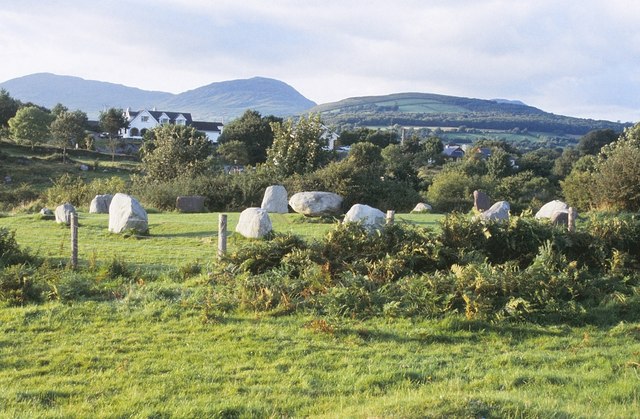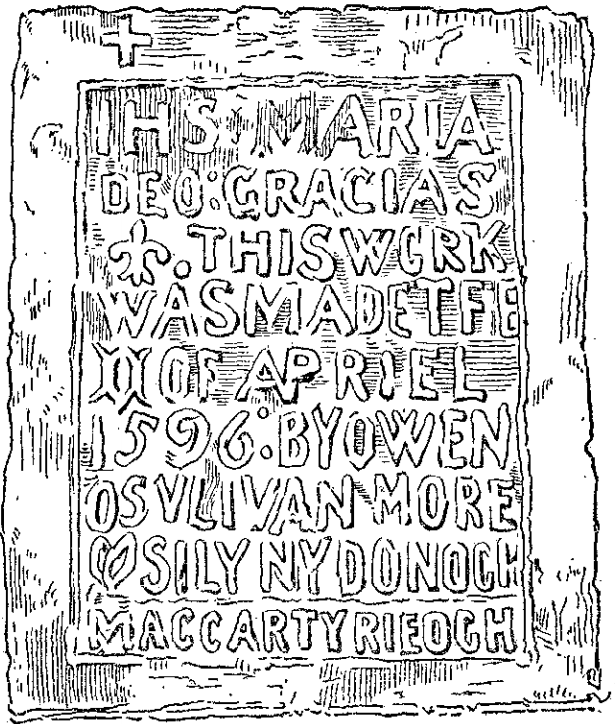|
Templenoe
Templenoe () is a civil parish in County Kerry, Ireland. It is situated four miles from Kenmare, on the N70 road to Sneem, which forms part of the Ring of Kerry. Templenoe is the location of the Ring of Kerry golf club. There is a Gaelic Athletic Association ground, a pier, and a Catholic chapel of ease for the Kenmare parish. Dromore Castle, Dunkerron Castle and Dromquinna House are located in the area. Templenoe GAA is the local Gaelic Athletic Association club. The Gaelic football Gaelic football (; short name '')'', commonly known as simply Gaelic, GAA, or football, is an Irish team sport. A form of football, it is played between two teams of 15 players on a rectangular grass pitch. The objective of the sport is to score ... playing brothers of the County Kerry team, Pat Spillane, Mick Spillane and Tom Spillane, were each born in Templenoe. See also * List of towns and villages in Ireland References Civil parishes of County Kerry {{Kerry-geo-st ... [...More Info...] [...Related Items...] OR: [Wikipedia] [Google] [Baidu] |
Templenoe GAA
Templenoe GAA ( Irish: ''CLG Teampall Nua'') is a Gaelic Athletic Association club from Templenoe in County Kerry, Ireland. The club competes as a joint divisional side with other clubs from the Kenmare area like Tuosist GAA in the county championship and as an individual club in other competitions. Hurling was by far the stronger of the two codes until the 1920s. However, since then Gaelic football has taken pride of place and hurling is no longer played in the club. The club was founded in 1933 but did not affiliate to the GAA until 1938. History The first club meeting was held in 1933 in the Merino House. Dan O'Reilly became the club's first chairman and P.D.M. O'Sullivan became the first secretary. Joe O'Neill was elected treasurer that day and stayed treasurer until 1966. In 1958 Templenoe merged with another Templenoe club from the Blackwater area, which was founded in 1942. The club played in the 1903 Kerry Senior Hurling Championship. In their only outing they suf ... [...More Info...] [...Related Items...] OR: [Wikipedia] [Google] [Baidu] |
Pat Spillane
Patrick Gerard Spillane (born 1 December 1955), better known as Pat Spillane, is an Irish former Gaelic football pundit and player. His league and championship career at senior level with the Kerry county team spanned seventeen years from 1974 to 1991. Spillane is widely regarded as one of the greatest players in the history of the game. Born in Templenoe, County Kerry, Spillane was born into a strong Gaelic football family. His father, Tom, and his uncle, Jerome, both played with Kerry and won All-Ireland medals in the junior grade. His maternal uncles, Jackie, Dinny, Mickey, and Teddy Lyne, all won All-Ireland medals at various grades with Kerry throughout the 1940s and 1950s. Spillane played competitive Gaelic football as a boarder at St Brendan's College. Here he won back-to-back Corn Uí Mhuirí medals, however, an All-Ireland medal remained elusive. Spillane first appeared for the Templenoe club at underage levels, before winning a county novice championship medal in ... [...More Info...] [...Related Items...] OR: [Wikipedia] [Google] [Baidu] |
Tom Spillane
Tom Spillane (born 1962) is an Irish former Gaelic footballer who played for Templenoe and the Kerry county team in the 1980s. Early life Maura Spillane gave birth to Tom in Templenoe, near Kenmare, County Kerry in 1962. He was — along with his brothers Pat Spillane, Pat and Mick Spillane, Mick — destined to become a key member of the successful Kerry Gaelic football Gaelic football (; short name '')'', commonly known as simply Gaelic, GAA, or football, is an Irish team sport. A form of football, it is played between two teams of 15 players on a rectangular grass pitch. The objective of the sport is to score ... teams of the 1980s. Playing career Spillane won an All-Ireland Minor Football Championship (MFC) medal in 1980 before first breaking into the county panel in 1981. He played with Kerry for the next eleven seasons, winning four All-Ireland Senior Football Championship (SFC) medals, five Munster Senior Football Championship, Munster SFC medals, one Kerry Senior Fo ... [...More Info...] [...Related Items...] OR: [Wikipedia] [Google] [Baidu] |
Kenmare
Kenmare () is a small town in the south of County Kerry, Ireland. The name Kenmare is the anglicised form of ''Ceann Mara'', meaning "head of the sea", referring to the head of Kenmare Bay. It is also a townland and civil parish. Location Kenmare is located at the head of Kenmare Bay (where it reaches the farthest inland), sometimes called the Kenmare River, where the Roughty River (''An Ruachtach'') flows into the sea, and at the junction of the Iveragh Peninsula and the Beara Peninsula. It is also located near the MacGillycuddy's Reeks, Mangerton Mountain and Caha Mountains and is a popular hillwalking destination. Nearby towns and villages are Tuosist, Ardgroom, Glengarriff, Kilgarvan, Killarney, Templenoe and Sneem. Kenmare is in the Kerry constituency of Dáil Éireann. History Evidence of ancient settlement in the Kenmare area includes one of the largest stone circles in the south-west of Ireland. Close to the town, this stone circle shows occupation in the area ... [...More Info...] [...Related Items...] OR: [Wikipedia] [Google] [Baidu] |
Dunkerron Castle
Dunkerron Castle () is a ruined four-storey tower house located in Templenoe, near Kenmare, County Kerry, in south-west Ireland. The castle was the family seat of the O'Sullivan Mór family from the late 16th century. History The four-storey tower house was built in the 13th century on a limestone outcrop as a Norman ( Carew) stronghold. Several later structures of the castle, including an enclosed court, date to the late 16th century, when Owen O'Sullivan became 'Chief of the Name' and acceded to the title of 'O'Sullivan Mór'. An inscribed plaque, dated 1596, recorded the castle's association with the O'Sullivan Mór and MacCarthy Reagh dynasties. The castle was the family seat of the O'Sullivan Mór for some time. The main O'Sullivan Mór familial seat moved to nearby Cappanacush Castle during the 17th century, and antiquary Samuel Lewis noted that both castles were "traditionally said to have been defended" by their O'Sullivan Mór owners during the mid-17th century Cromwe ... [...More Info...] [...Related Items...] OR: [Wikipedia] [Google] [Baidu] |
Dromore Castle (County Kerry)
Dromore Castle is a manor house in Templenoe, County Kerry, Ireland, looking out over the Kenmare River. It was built in the 1830s for the Mahony family to a neo-Gothic design by Sir Thomas Deane. Building Dromore Castle was designed and built for Denis Mahony by the architect Thomas Deane, probably assisted by his brother Kearns Deane. Work began in 1831, although the account books show that only a negligible amount had been carried out before May 1834. Building work was completed in 1839. The house is in the castellated Gothic Revival style, with an external finish of Roman Cement with limestone dressings. With the notable exception of the grand south facing window with its pointed arch, the windows consist of pointed tracery contained within rectangular frames, a style characteristic of Deane's domestic work. The entrance hall, which is in the form of a long gallery, takes up half of the area of the ground floor. The west wing of the Castle takes the form of a rou ... [...More Info...] [...Related Items...] OR: [Wikipedia] [Google] [Baidu] |
List Of Towns And Villages In The Republic Of Ireland
This is a link page for cities, towns and villages in the Republic of Ireland, including townships or urban centres in Dublin, Cork, Limerick, Galway, Waterford and other major urban areas. Cities are shown in bold; see City status in Ireland for an independent list. __NOTOC__ A B C D E F G H I J K L M N O P Q R S T U V W Y See also * List of places in Ireland ** List of places in the Republic of Ireland **List of urban areas in the Republic of Ireland as defined by the Central Statistics Office. Includes non-municipal towns and suburbs outside municipal boundaries *** List of urban areas in the Republic of Ireland/2011 census *** List of urban areas in the Republic of Ireland/2006 census *** List of urban areas in the Republic of Ireland/2002 census ** List of cities, boroughs and towns in the Republic of Ireland, with municipal councils and legally defined boundaries up to 2014 ... [...More Info...] [...Related Items...] OR: [Wikipedia] [Google] [Baidu] |
Kerry GAA
The Kerry County Board of the Gaelic Athletic Association (GAA), or Kerry GAA, is one of the 32 County board (Gaelic games), county boards of the GAA in Ireland. It is responsible for Gaelic games in County Kerry, and for the Kerry county teams. The Kerry branch of the Gaelic Athletic Association was founded in 1888. Gaelic football, Football is the dominant sport in the county, with both the men's and women's teams among the strongest in the country at senior level. The Kerry county football team, county football team was the fourth from the Provinces of Ireland, province of Munster to win an All-Ireland Senior Football Championship (SFC), as well as to appear in the final, following Limerick county football team, Limerick, Tipperary county football team, Tipperary and Cork county football team, Cork. Kerry is the most successful in the history of the All-Ireland SFC, topping the All-Ireland Senior Football Championship records and statistics#By county, list of counties for All- ... [...More Info...] [...Related Items...] OR: [Wikipedia] [Google] [Baidu] |
Gaelic Football
Gaelic football (; short name '')'', commonly known as simply Gaelic, GAA, or football, is an Irish team sport. A form of football, it is played between two teams of 15 players on a rectangular grass pitch. The objective of the sport is to score by kicking or palming the ball into the other team's Goal (sport), goal (3 points) or between two upright posts above the goal and over a crossbar above the ground (1 point). Players advance the ball up the field with a combination of carrying, bouncing, kicking, hand-passing, and soloing (dropping the ball and then toe-kicking the ball upward into the hands). In the game, two types of scores are possible: points and goals. A point is awarded for kicking or hand-passing the ball over the crossbar, signalled by the umpire raising a white flag. Two points are awarded if the ball is kicked over the crossbar from a 40 metre range marked by a D-shaped arc, signalled by the umpire raising an orange flag. A goal is awarded for kicking the ball ... [...More Info...] [...Related Items...] OR: [Wikipedia] [Google] [Baidu] |
Castles Of Munster- Dunkerron, Kerry (2) (geograph 3037291)
A castle is a type of fortified structure built during the Middle Ages predominantly by the nobility or royalty and by military orders. Scholars usually consider a ''castle'' to be the private fortified residence of a lord or noble. This is distinct from a mansion, palace, and villa, whose main purpose was exclusively for ''pleasance'' and are not primarily fortresses but may be fortified. Use of the term has varied over time and, sometimes, has also been applied to structures such as hill forts and 19th- and 20th-century homes built to resemble castles. Over the Middle Ages, when genuine castles were built, they took on a great many forms with many different features, although some, such as curtain walls, arrowslits, and portcullises, were commonplace. European-style castles originated in the 9th and 10th centuries after the fall of the Carolingian Empire, which resulted in its territory being divided among individual lords and princes. These nobles built castles ... [...More Info...] [...Related Items...] OR: [Wikipedia] [Google] [Baidu] |





